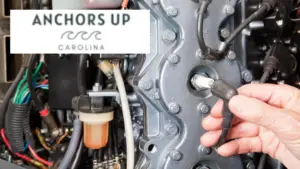Without a spark a marine outboard engine would fail to run. For this reason, the spark plugs in a marine engine are a critical component. Outboard boat motors come in different horsepower ratings and cylinder counts. The number of spark plugs in a marine engine is not standard across the board. Here is what to know about outboard spark plugs in marine engines.
What Is The Difference Between An Automobile Spark Plug And A Marine Spark Plug
Without a doubt, their is a difference between a marine spark plug and a standard automobile spark plug.
As a result of the damp and salty environment depending on where you’re operating marine spark plugs are constructed differently.
A marine spark plug is engineered with a corrosion resistant metal. The metal will not deteriorate as would a car engine’s spark plug.
I have changed spark plugs routinely on vessels that I have owned. Never have I noticed the onset of corrosion despite running in saltwater.
How Often Should Outboard Spark Plugs Be Changed
As an avid boater and former captain, I prefer to change my outboard engine spark plugs on a consistent basis.
The intervals vary based on the engine manufacturer but the average is every 100 hours. Exceeding the 100 hour mark on a set of spark plugs puts you at risk of unexpected combustion issues.
Importantly, the plugs can be removed, inspected, and reinstalled more frequently if you’re having concerns.
I do not want to be stranded on the ocean because I failed to swap my spark plugs. For this reason, it is essential to monitor the engine hours and replace them after 100 hours of run time. Trust me, it is not worth the risk. The cost of a tow will be greater than the cost of the outboard plugs.
Important Factors When Changing Marine Spark Plugs
Fortunately, the process for changing spark plugs is simple. The most basic mechanically inclined individuals can change spark plugs compared to paying a high rate for a mechanic.
Purchase The Correct Replacement Plugs
Unquestionably, your outboard motor boat manual is your best resource for purchasing the correct replacement plugs. The spark plug requirements will be defined within the manual.
However, the second option is to remove a plug and bring it to the marine supply store. The parts department will be able to match what was already in place.
Failing to reinstall the correct plugs will negatively impact performance. Poor performance results in increased fuel burn and reduced engine power.
Use The Proper Wrench
All too often boat owners fail to use the proper wrench to remove marine engine spark plugs. The improper wrench such as an adjustable puts you at risk of the striping the plug.
For this reason, it is critical to use a spark plug socket that fits the shell. Failing to fit the shell properly will round the square edges making it more challenging to remove.
Apply Anti Seize Grease
Anti seize grease is particularly important in harsh marine environments. The grease is intended to coat the threads before they are installed into the outboard engine powerhead.
Applying anti seize grease does exactly what it says, it prevents the spark plugs from becoming seized up after they are installed.
The next time you’re replacing your spark plugs, apply anti seize grease to the threads. This will allow you to remove them with ease during the next maintenance interval.
Do Not Over Tighten
Over tightening is a major issue when replacing spark plugs. An over torqued spark plug is likely to become misshapen. However, continuing to torque the plug is likely to cause it to snap or damage the threads.
A broken spark plug presents a challenge to remove and replace. For this reason, it should never be over-tightened.
To properly tighten a spark plug, I suggest using a torque wrench. A torque wrench will prevent the plugs from being over tightened. The wrench is adjustable to set the proper amount of torque specified by the engine manual.
However, if you don’t have a torque wrench, I recommend tightening the plug by hand. Once it is hand tight, take a half turn with the spark plug socket.
Test The Engine
Once the plugs are swapped, I suggest testing the boat motor to ensure that it is in proper working condition.
Importantly, if the vessel is out of the water, it is imperative to connect the motor to a garden hose. Without waterflow, you put yourself at risk of damaging the internal components of the engine as a result of heat.
Conversely, if you’re testing in the water, I recommend running the motor dockside before heading out into the open water.
Outboard Spark Plugs Are Easy To Replace
No point in hiring a mechanic to replace marine engine spark plugs. The process is simple and can be done virtually anywhere. Spark plugs are critical components to a sound running engine. Importantly, the plugs should be changed after 100 hours of operation. Don’t be stranded out on the water by ignoring basic maintenance.








